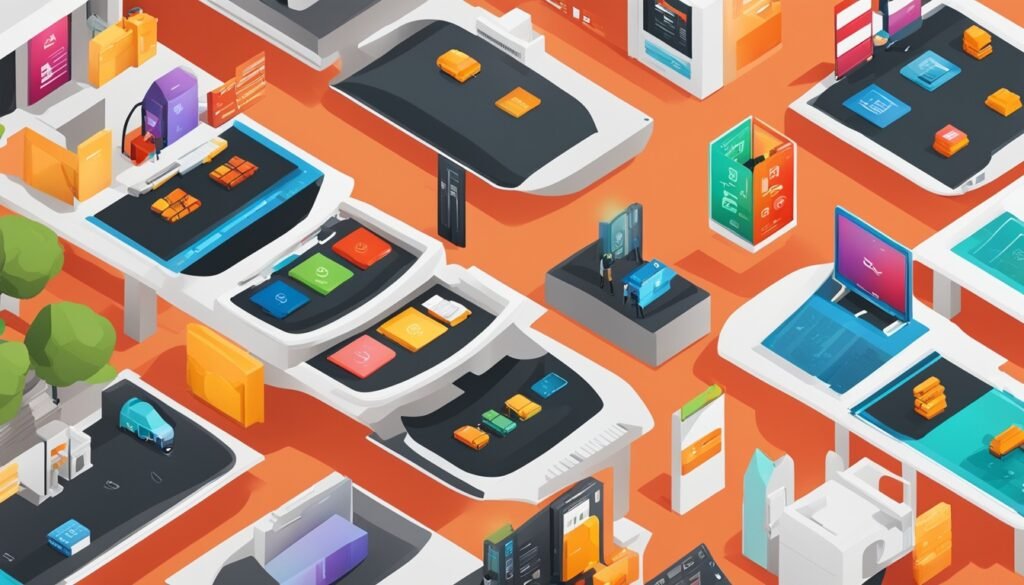The digital marketplace is booming, with global e-commerce sales set to hit $6.3 trillion in 2024. We’re seeing a massive shift towards online shopping. E-commerce now accounts for 15.4% of total sales. This guide will walk you through the essentials of launching your own e-commerce store in this thriving landscape.
Starting an e-commerce business involves careful planning and execution. From choosing the right business model to setting up your digital storefront, we’ll cover all the crucial steps. Whether you’re considering dropshipping, direct-to-consumer, or subscription services, we’ll help you navigate the options.
In this guide, we’ll explore popular platforms like Shopify and WooCommerce. We’ll discuss inventory management for craft businesses. And we’ll touch on legal requirements such as business registration and licensing. Let’s dive into the world of online retail and set you up for success in the digital marketplace.
Understanding E-commerce Business Models
E-commerce has changed how we buy and sell things. Now, businesses use different models to reach their customers. Let’s look at the main types of e-commerce models and what makes them special.
Business-to-Customer (B2C)
B2C is the most common e-commerce model. It means businesses sell directly to people. Companies like Amazon and eBay use this model. It makes buying easier, which means lower marketing costs and smaller average orders.
Business-to-Business (B2B)
B2B e-commerce is about companies selling to other companies. It’s steady and profitable because of long contracts and bigger orders. In 2021, 60% of B2B buyers were millennials, showing how important online B2B sales are getting.
Customer-to-Customer (C2C)
C2C, or peer-to-peer, connects people for buying and selling. Sites like eBay help with these deals, taking a cut of the sale. This model lets people make money from what they own or do.
Customer-to-Business (C2B)
In C2B, people sell things or services to companies. It’s flexible for consumers and lets companies find talent worldwide. It’s big in the gig economy and freelance world.

| Model | Key Feature | Example |
|---|---|---|
| B2C | Direct sales to consumers | Amazon |
| B2B | Long-term contracts | Alibaba |
| C2C | Peer-to-peer transactions | eBay |
| C2B | Individuals selling to businesses | Upwork |
Knowing about these e-commerce models is key for entrepreneurs wanting a successful online store. Each model meets different market needs and offers unique chances in the growing online shopping world.
Choosing Your Niche and Target Audience
Choosing the right niche for your ecommerce website is key. We must think about making money, being easy to find, and being passionate about it. Let’s explore how to find a great niche and the right audience for your online store.

Start by researching possible niches. Look at things like price, quality, and who might buy it. This helps you find specific groups of customers. Use Google Trends to see how popular certain niches are.
Then, check if your niche is a good choice. Think about what makes you unique, combining niches, or breaking them down. It should match your interests and skills. Niche ecommerce sites focus on specific groups of people.
“By carving out a niche and becoming a go-to business for a specific audience, it helps in building brand loyalty, with customers more likely to choose a specialized brand over a mass market one.”
Did you know? Fewer than a million online stores make over $1,000 a month. But, some do well. For example, Touchland sold 10,000 dispensers to big brands in just three months. A Year of Dates went from a small project to a worldwide hit.
| Benefits of Niche Marketing | Impact |
|---|---|
| Reduced advertising costs | More cost-efficient campaigns |
| Builds brand loyalty | Customers prefer specialized brands |
| Showcases expertise | Builds trust and credibility |
| Increases profits | Effective catering to specific groups |
Your ecommerce site should give shoppers a personal experience, helpful content, and a community feel. This makes customers loyal and active in your brand’s community.
Developing Your Product Line
Starting a successful web store begins with a strong product line. We’ll look at how to find products, check if they’re good, and set the right prices for your online store.
Sourcing Products
Finding the right products is key to your online store’s success. You can make them yourself, work with wholesalers, or use dropshipping. Each way has its good and bad points. Pick what fits your budget and goals.

Evaluating Product Viability
Before adding products to your store, see if they’ll do well. Think about how much they cost to make, if people want them, and how to ship them. Use tools like Google Trends to see if people are interested. Last year, 46% of U.S. consumers tried new brands, showing they’re open to new things.
Pricing Strategies
Setting the right prices is crucial for making money. Consider what it costs to make the product, what others charge, and how much people value it. With half of online spending on smartphones, make sure your prices work on all devices. Think about using dynamic pricing to stay competitive.
| Pricing Strategy | Description | Best For |
|---|---|---|
| Cost-plus | Add a fixed percentage to the product cost | New stores with unique products |
| Competitive | Set prices based on market rates | Established stores in crowded niches |
| Value-based | Price according to perceived customer value | Premium or luxury items |
Building your product line is a continuous process. Be ready to change your strategies as you learn more about your customers and the market. With the right approach to online merchandising, your web store can do well in the competitive e-commerce world.
Building Your E-commerce Store
Creating a successful e-commerce store takes careful planning and execution. We’ll help you set up your Click-and-Buy platform. Start by choosing the right e-commerce platform. Options like Shopify, Square Online, and Squarespace offer various features for different business needs. Shopify is a good choice for businesses selling physical products online, with a basic plan at $29 per month.
After picking a platform, build your website. This means choosing a domain name, picking a template, and customizing your pages. Add your products, set up payment processing, and configure tax and shipping settings. Many platforms, like Shopify, offer built-in payment solutions to make things easier. Always test your Click-and-Buy functionality before launching to ensure a smooth experience for customers.
Search engine optimization (SEO) is key for your e-commerce success. Use relevant title tags, meta descriptions, and properly tagged images to boost your site’s visibility. By 2024, U.S. e-commerce revenue is expected to hit $476 billion. Optimizing your store for search engines can help you tap into this growing market. Also, consider working with other online marketplaces like Amazon or Instagram to reach more customers and increase your Click-and-Buy potential.



